
This edition of Directions in Highway Safety, GHSA's member newsletter, features a recap of the 2022 Annual Meeting, an update on NHTSA's Notice of Proposed Rulemaking and the latest association projects and reports, member spotlight and more.
Quick Links: Cover Story | Executive Director's Report | From Washington | State of the States | Did You Know? | From Our Perspective
Redefining Possible at #GHSA2022
GHSA's 2022 Annual Meeting in Louisville was an overwhelming success thanks to a fantastic line-up that included expert speakers, engaging workshops, cutting-edge safety products and programs in the exhibit hall, and plenty of networking opportunities. General sessions explored safety on America's rural roads, vehicle technology and the status of autonomous vehicles, the role of behavioral safety in the Safe System approach, and what it will take to make distracted driving socially unacceptable.
To kick off the meeting, National Highway Traffic Safety Administration Acting Administrator Ann Carlson discussed the agency's traffic safety efforts with a focus on the U.S. Department of Transportation's National Roadway Safety Strategy and the adoption of the Safe System approach. Waymo Chief Safety Officer Mauricio Peña then reviewed the company's efforts to develop autonomous vehicle (AV) technology and announced a new partnership with GHSA to develop and pilot an AV technology training program for first responders in 2023.
During our Welcome Luncheon, Commissioner William J. Bratton, the only person to lead the police departments of America's two largest cities, spoke to attendees about the importance of providing equitable, community-based law enforcement. His remarks, which focused on the intersection between crime prevention and safety on the road, resonated with the audience of more than 650 highway safety professionals from across the country.
A panel of national traffic safety leaders joined by GHSA Executive Director Jonathan Adkins explored what states and communities should focus on to advance the elements of the Safe System approach. Each panelist offered insights on the approach's five elements: safer people, safer roads, safer vehicles, safer speeds and better post-crash care.
Distracted driving is one of our nation's most pervasive yet preventable traffic safety problems. Our report with General Motors urges a broad culture shift to make this deadly behavior socially unacceptable. A general session, moderated by GHSA Senior Director of External Engagement Pam Shadel Fischer, featured a panel of national experts who shared what their organizations are doing to combat driver distraction. The panel then engaged in a discussion with the audience to explore the challenges, countermeasures and promising practices discussed in the report.
Almost half of U.S. motor vehicle fatalities occur on rural roads, but only 19% of the nation's population lives in rural areas. Toxcel Senior Scientist Paula Raymond, the author of our newly released report with State Farm, provided an overview of how risky driving behaviors contribute significantly to the problem. A panel of rural road safety experts, moderated by Maine Bureau of Traffic Safety Director Lauren Stewart, then discussed how to address these challenges along with proven and promising countermeasures for improving safety on these beautiful yet deadly roads.
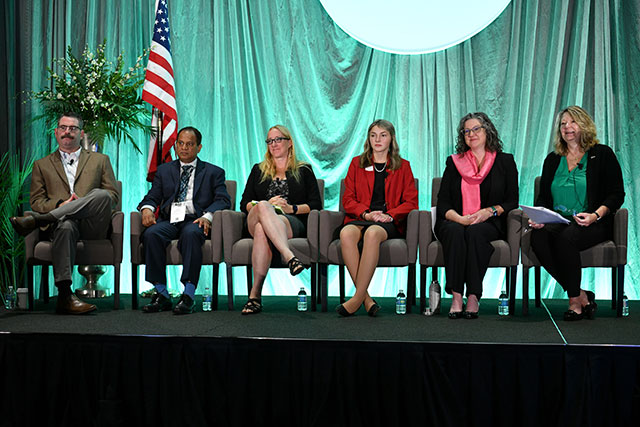
The meeting concluded with a conversation between "CBS Sunday Morning" host Jane Pauley and Louisiana Highway Safety Commission Executive Director Lisa Freeman. Pauley, one of the world's most respected journalists, discussed her distinguished career, her personal experience and advocacy on mental health and how she reinvented herself late in her career.

During her conversation with Freeman, Pauley stressed that "we can't let the fear of making mistakes prevent us from trying new things." Through our continued commitment and partnerships, this is how we redefine possible in traffic safety. For those who joined us in person or via webcast, thank you for supporting GHSA and partnering with us to prevent roadway deaths. We look forward to seeing you in New York City, August 12-16, for what is sure to be a great meeting.

Building on the Success of GHSA's Annual Meeting
One month ago, many of us gathered in Louisville for what was one of our most successful Annual Meetings to date. For many, this was their first in-person event since the start of the pandemic, and it was evident in the level of enthusiasm exhibited by all in attendance. I came away from the event energized and ready to put what I learned into action.
I was particularly motivated by the remarks of our Closing Luncheon speaker, award-winning journalist Jane Pauley. Her advice about not being afraid to fail resonated with me. To be willing to try new things – not necessarily forging a new career as she did, but finding new ways to approach challenges in our current jobs and identifying new opportunities – is essential for keeping us motivated and engaged.
We're committed to doing just that at GHSA – trying new things and not being afraid to fail. One of the goals in our strategic plan is to deepen our engagement with all State Highway Safety Office (SHSO) staff. We're doing that by developing a new Emerging Highway Safety Leaders training for non-director level staff that will be piloted next April. The course curriculum will address highway safety administration and planning topics and the core principles of leadership. We believe this will be tremendously valuable to those rising staff who are the next generation of SHSO leaders. Keep an eye on your inbox for more details on the course and registration information.
Having the opportunity to connect in person with the more than 40 partners who sponsored our Annual Meeting was another highlight of my time in Louisville. I'm particularly grateful to the Highway Safety Champions that work with us and our members throughout the year. Just last week, we began accepting applications for another round of state grants from Ford Motor Company Fund. In this, our 20th year of partnership, we're working with Ford to provide states up to $25,000 in unrestricted funding to implement community-based teen traffic safety programs that advance GHSA and Ford's shared focus on equity and inclusion.
The success of this year's Annual Meeting would not have been possible without the support and hard work of our host, the Kentucky Office of Highway Safety. I'm deeply grateful for their partnership and hospitality. I also want to thank the Annual Meeting Committee, under the leadership of Carol Gould, for their time and effort planning and developing an ambitious slate of 20 workshops that addressed the important challenges we face today. Finally, I'm particularly proud of the tireless work and dedication of GHSA's staff in making it an event to remember. As I've said before, our small but mighty staff are miracle workers, making the impossible happen.
Speaking of GHSA's fantastic team, I am thrilled to welcome Olivia Greer as our new Programs Coordinator. A fun fact about our newest team member is that early in her career she managed a grant from the Georgia Governor's Office of Highway Safety. Olivia is handling our federal and private sector partnerships, state grant programs, partner webinars and events.
Our biggest 2022 event may be in the books, but we have much more coming your way in 2023. I encourage you to take advantage of our resources, programs and expertise and hope to see you in New York City next August.
Welcome New Members
GHSA is pleased to welcome the following new Associate Members. Click below to learn about their mission and services:
- Chesapeake Region Safety Council
- Ehline Law Firm Personal Injury Attorneys, APLC
- Pacific Institute for Research & Evaluation (PIRE)
- SaferStreet Solutions
- The Platta Law Firm

NHTSA Revising Grant Rules
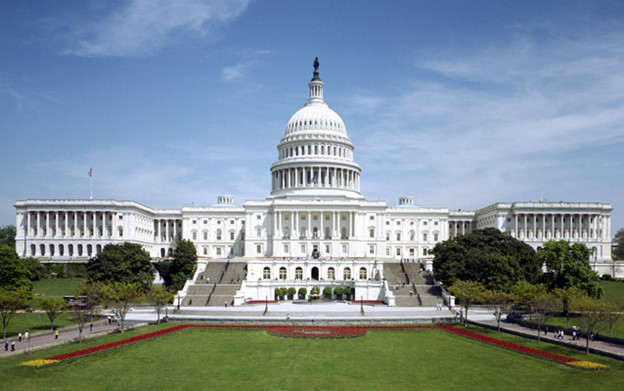 On September 15, NHTSA released its Notice of Proposed Rulemaking (NPRM), which outlines the changes to state grant regulations in the Infrastructure Investment and Jobs Act (IIJA) signed into law last year. This 91-page revision of 23 CFR Part 1300 presents the most momentous regulatory change for SHSOs and their grantees since the rules were last revised in 2018. SHSOs in particular should closely scrutinize the full text of the NPRM and start planning for the next Federal fiscal year.
On September 15, NHTSA released its Notice of Proposed Rulemaking (NPRM), which outlines the changes to state grant regulations in the Infrastructure Investment and Jobs Act (IIJA) signed into law last year. This 91-page revision of 23 CFR Part 1300 presents the most momentous regulatory change for SHSOs and their grantees since the rules were last revised in 2018. SHSOs in particular should closely scrutinize the full text of the NPRM and start planning for the next Federal fiscal year.
The NPRM implements many changes directed by Congress. The most significant is a transition from an annual highway safety plan (HSP) to a triennial HSP beginning next year. While the triennial HSP will be more program-focused, each year states will also submit an annual grant application describing planned safety projects. States should review the required elements for each of these submissions.
Within the NPRM, you will find numerous revisions to the Section 405 National Priority Safety Grants, new but limited flexibility to use federal funds for automated enforcement and NHTSA plans to improve program transparency. States will also find greater eligibility for grants and more opportunities to use federal funding for a wider range of safety purposes.
The NPRM does present an opportunity, for the first time, to weigh in on many new proposals with a significant potential impact on state compliance. NHTSA has notably included a detailed proposal for how states would incorporate public participation and engagement in highway safety program planning, especially programs involving traffic enforcement. The agency has also proposed critical adjustments to how federal funding must be expended by or on behalf of local partners. The rules for how states must justify the countermeasures they select have been adjusted and many elements have been added to annual reports that SHSOs must submit after the end of each fiscal year. These and other proposed changes create new challenges for SHSOs that GHSA has called to NHTSA's attention.
States also remain concerned about the new requirement that highway safety performance targets are required to be "constant or improving." GHSA has sought NHTSA guidance on how performance target setting can still be data-driven while meeting this Congressionally-directed standard.
Public comments are due on October 31. We have prepared comments on behalf of the association and we encourage all states and partners to weigh in, if able. NHTSA anticipates issuing a Final Rule codifying these changes by next year when states will submit the first triennial HSPs for FFY 2024-26. Leading into next summer, expect to hear more from both NHTSA and GHSA about these important developments.

New GHSA Programs Coordinator
 Olivia Greer, GHSA's new Programs Coordinator, is looking forward to working with members as she manages the association's federal and private sector grant programs and handles logistics for program-related webinars and events. She can be reached at ogreer@ghsa.org.
Olivia Greer, GHSA's new Programs Coordinator, is looking forward to working with members as she manages the association's federal and private sector grant programs and handles logistics for program-related webinars and events. She can be reached at ogreer@ghsa.org.
New Grant Projects Underway to Address Distracted and Impaired Driving
 GHSA, in collaboration with General Motors (GM), is providing a total of $210,000 to seven SHSOs to combat the prevalent and preventable problem of distracted driving. Seven states – Colorado, Kentucky, Maryland, Massachusetts, Missouri, Montana, Nebraska – have each been awarded $30,000 to implement recommended actions outlined in a comprehensive report released by GHSA and GM earlier this year.
GHSA, in collaboration with General Motors (GM), is providing a total of $210,000 to seven SHSOs to combat the prevalent and preventable problem of distracted driving. Seven states – Colorado, Kentucky, Maryland, Massachusetts, Missouri, Montana, Nebraska – have each been awarded $30,000 to implement recommended actions outlined in a comprehensive report released by GHSA and GM earlier this year.
In partnership with Lyft and with support from the Foundation for Advancing Alcohol Responsibility (Responsibility.org), GHSA awarded the Colorado, Maryland, Missouri and Texas SHSOs a total of $80,000 in grant funds to support initiatives to prevent impaired driving this holiday season. The states will implement campaigns to encourage people who consume alcohol or other impairing substances to make the safer choice and use Lyft as an alternative to driving impaired.

GHSA Publishes Two Reports Targeting Risky Behaviors
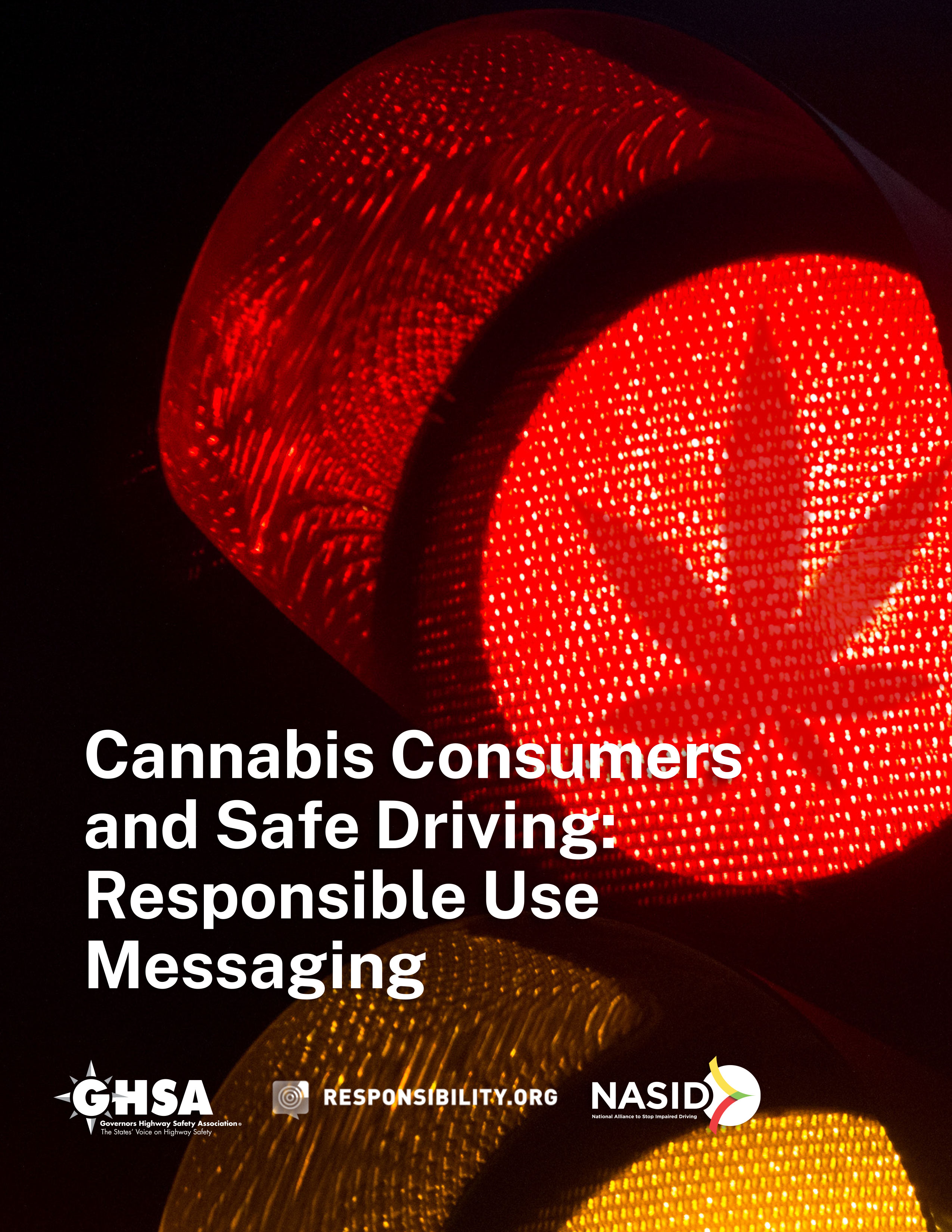 GHSA's report with Responsibility.org and the National Alliance to Stop Impaired Driving (NASID), Cannabis Consumers and Safe Driving: Responsible Use Messaging, provides guidance on how SHSOs can better communicate with cannabis consumers about safe driving and offers recommendations about the types of messages that do and don't work. The report highlights lessons learned, discusses promising practices that all SHSOs should consider when developing messages and offers a series of recommendations.
GHSA's report with Responsibility.org and the National Alliance to Stop Impaired Driving (NASID), Cannabis Consumers and Safe Driving: Responsible Use Messaging, provides guidance on how SHSOs can better communicate with cannabis consumers about safe driving and offers recommendations about the types of messages that do and don't work. The report highlights lessons learned, discusses promising practices that all SHSOs should consider when developing messages and offers a series of recommendations.
A recent Insurance Institute for Highway Safety (IIHS) survey found that of those motorists who consumed marijuana, 41% reported using the drug two hours or less before driving. A third of drivers who drank alcohol and used marijuana at the same time reported getting behind the wheel within two hours of consumption.
"Those results show there's more work ahead to educate the driving public about the increased risk of impairment associated with alcohol, marijuana and the combination of the two substances," said IIHS President David Harkey.
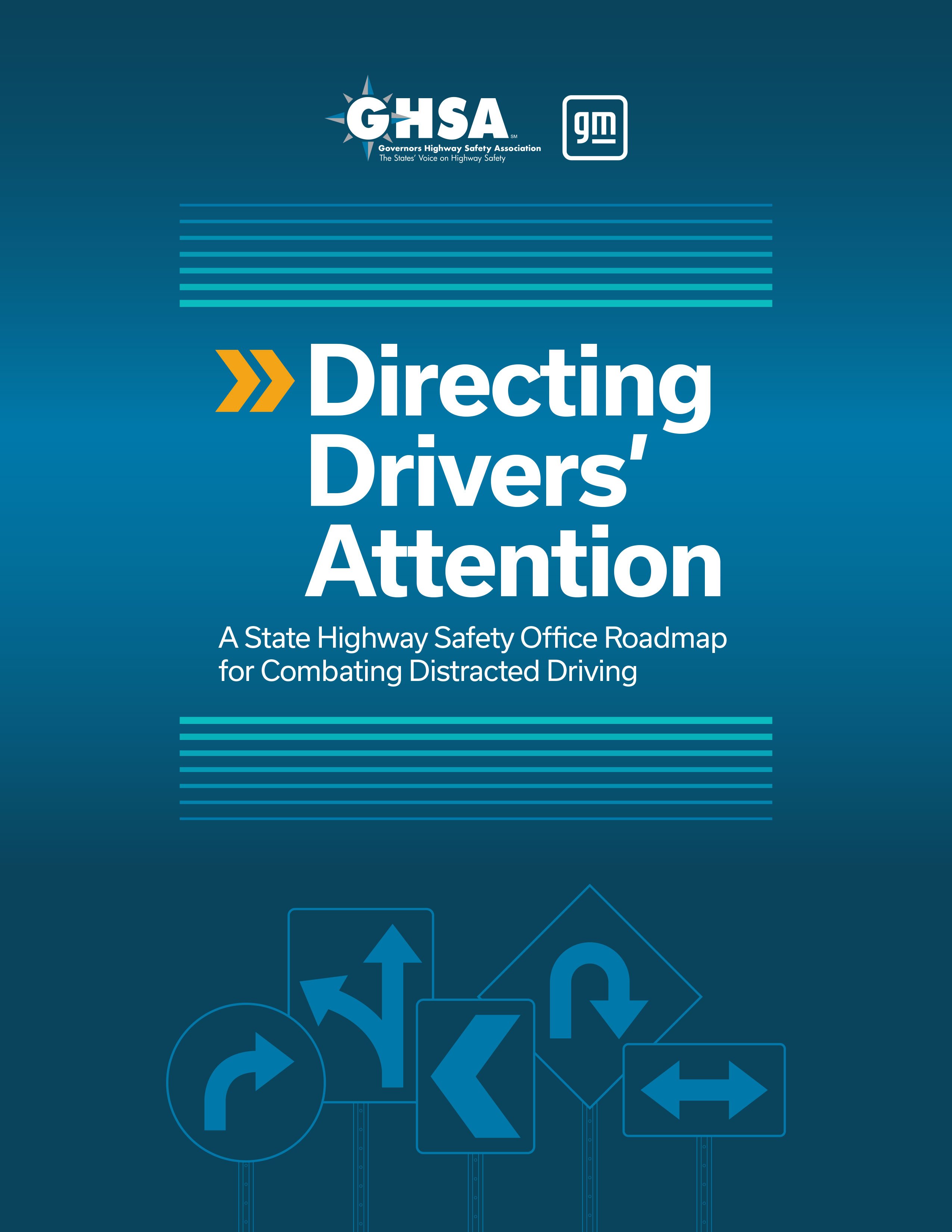 In June, GHSA released Directing Drivers' Attention: A State Highway Safety Office Roadmap for Combating Distracted Driving, a report that offers one of the most comprehensive looks at this underreported problem and urges a broad culture shift to make this deadly behavior socially unacceptable. Funded by General Motors, the report examines data shortcomings and other obstacles impacting efforts to reduce distracted driving, reviews SHSO initiatives and the challenges impacting those efforts, and provides 29 action-oriented recommendations. A safety advocate working to advance hand-held cell phone bans in all 50 states called it "an important roadmap for all highway safety professionals."
In June, GHSA released Directing Drivers' Attention: A State Highway Safety Office Roadmap for Combating Distracted Driving, a report that offers one of the most comprehensive looks at this underreported problem and urges a broad culture shift to make this deadly behavior socially unacceptable. Funded by General Motors, the report examines data shortcomings and other obstacles impacting efforts to reduce distracted driving, reviews SHSO initiatives and the challenges impacting those efforts, and provides 29 action-oriented recommendations. A safety advocate working to advance hand-held cell phone bans in all 50 states called it "an important roadmap for all highway safety professionals."
New Report Details Rural Road Risks
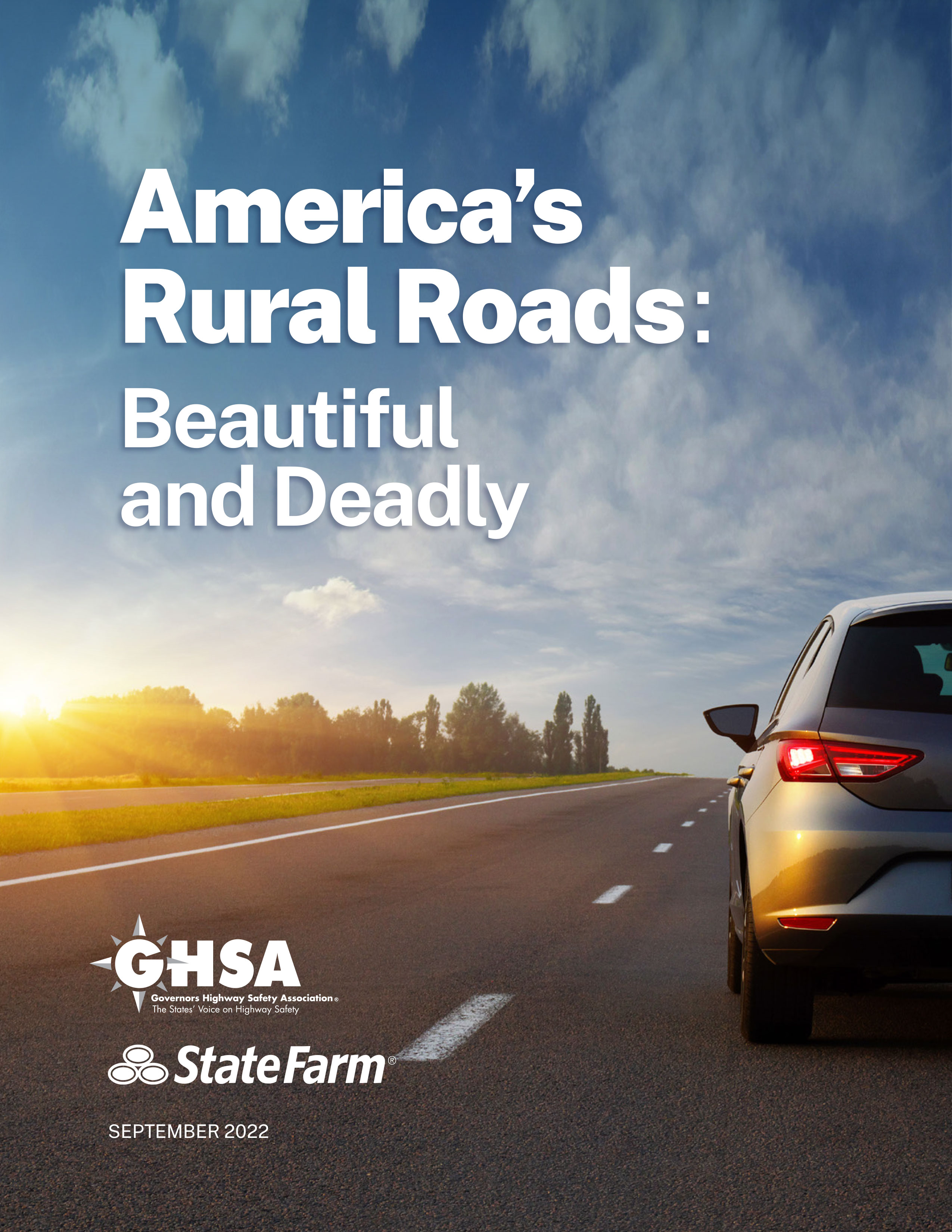 Rural roads are beautiful, but they’re hiding a deadly secret – nearly half of all fatal crashes occur on them, even though only 19% of the U.S. population lives in rural areas. The latest report from GHSA, funded by State Farm®, explores the extent of the rural road safety problem and dives into the data to determine who dies in these crashes and what risky driving behaviors are key contributors. The report also offers nearly three dozen recommendations for State Highway Safety Offices (SHSOs) and their partners to help make rural roads safer.
Rural roads are beautiful, but they’re hiding a deadly secret – nearly half of all fatal crashes occur on them, even though only 19% of the U.S. population lives in rural areas. The latest report from GHSA, funded by State Farm®, explores the extent of the rural road safety problem and dives into the data to determine who dies in these crashes and what risky driving behaviors are key contributors. The report also offers nearly three dozen recommendations for State Highway Safety Offices (SHSOs) and their partners to help make rural roads safer.
On November 15 at 1:00 p.m. ET, the National Center for Rural Road Safety and NLTAPA Safety Work Group will host a webinar discussion about the findings of the report. GHSA Senior Director of External Engagement Pam Shadel Fischer will join representatives from Wisconsin and Wyoming who will also share some promising practices they've implemented in their state. Be sure to check our website for more details; a link to register for the webinar will be added soon.
GHSA Publishes 2022 Annual Report
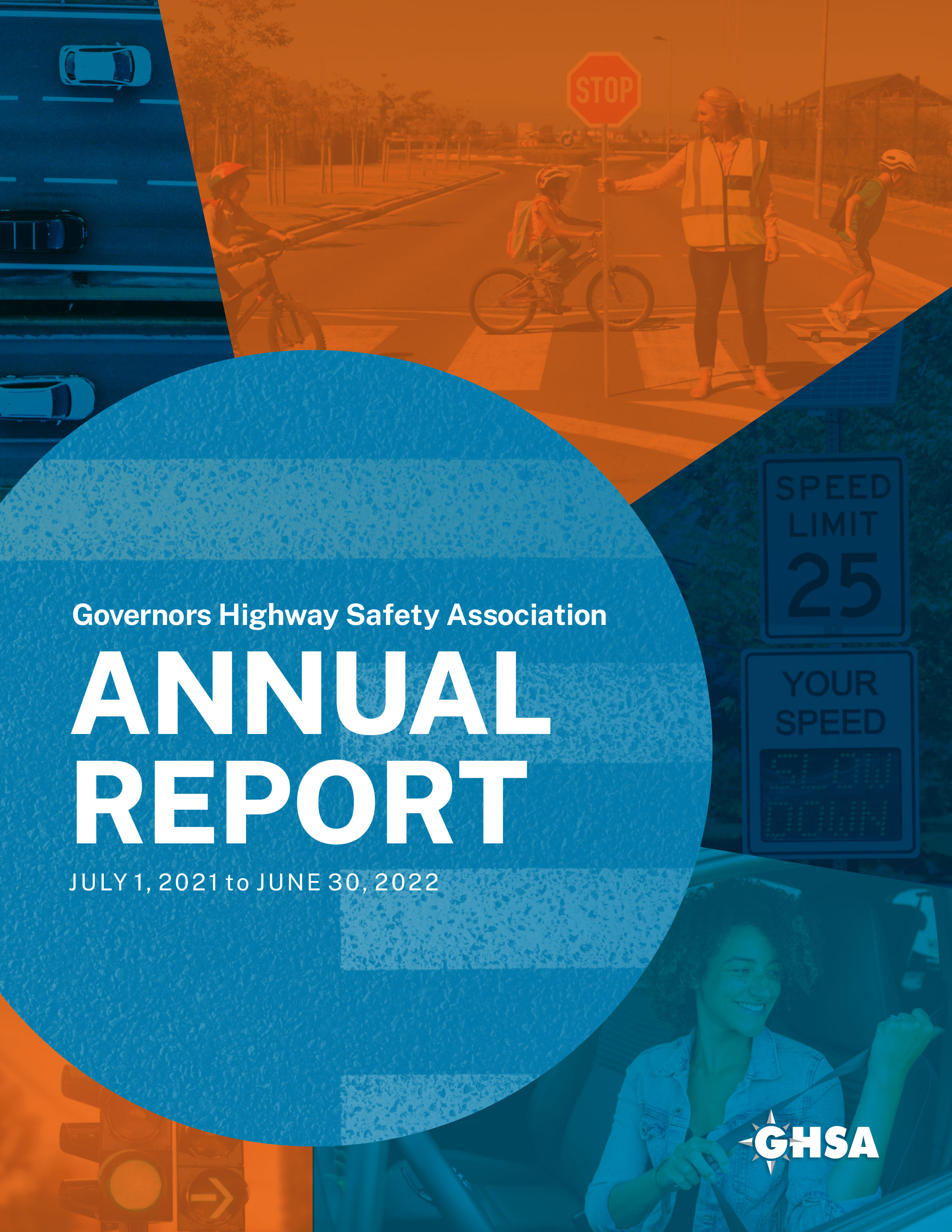 GHSA's Annual Report highlights the association's accomplishments for the 2022 Fiscal Year (July 1, 2021 – June 30, 2022). It provides updates on GHSA's activities and achievements, focusing on three key areas: collaborating with Congress and federal agencies, advancing traffic safety issues and expanding and delivering member services.
GHSA's Annual Report highlights the association's accomplishments for the 2022 Fiscal Year (July 1, 2021 – June 30, 2022). It provides updates on GHSA's activities and achievements, focusing on three key areas: collaborating with Congress and federal agencies, advancing traffic safety issues and expanding and delivering member services.
New Project to Improve Law Enforcement Practices and Traffic Safety
The Johns Hopkins Center for Injury Research and Policy was awarded a five-year, $5.3 million cooperative agreement from NHTSA to reduce traffic deaths and injuries by developing and piloting innovative strategies for traffic law enforcement to address speeding, seat belt use and impaired driving.
The project, Innovative Approaches to Advancing Traffic Safety and Enforcement, brings together experts in law enforcement, public health, and traffic safety to conduct research and develop recommendations for law enforcement practices that maximize safety and equity. It will focus on research and evaluation of methods and tools law enforcement personnel can use to enhance traffic safety while also reducing the potential for conflict associated with traditional traffic stops.
GHSA has reached out to the Johns Hopkins team to offer assistance as the project moves forward. Read about it here.
New E-Scooter Report Indicates Research Not Keeping Pace with Use
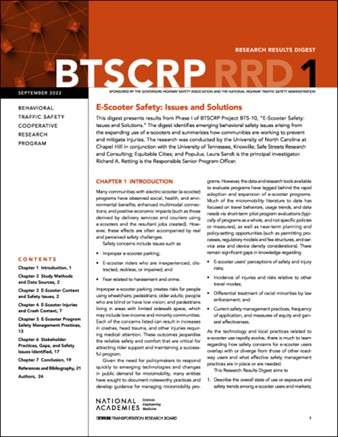 A new research report, E-scooter Safety: Issues and Solutions, released under the Behavioral Traffic Safety Cooperative Research Program (BTSCRP), found that research and data evaluating e-scooter safety are not keeping up with the rapid adoption and expansion of micromobility. It also discusses the safety trends among e-scooter users and characterizes the relationship between e-scooter crashes, injuries and fatalities, and behavioral and environmental contributing factors.
A new research report, E-scooter Safety: Issues and Solutions, released under the Behavioral Traffic Safety Cooperative Research Program (BTSCRP), found that research and data evaluating e-scooter safety are not keeping up with the rapid adoption and expansion of micromobility. It also discusses the safety trends among e-scooter users and characterizes the relationship between e-scooter crashes, injuries and fatalities, and behavioral and environmental contributing factors.
The BTSCRP report's findings mirror a previous GHSA report, Understanding and Tackling Micromobility: Transportation's New Disruptor. That report, published in 2020 and funded by State Farm®, identified six challenges posed by the rapid growth in the use of these devices that have resulted in a patchwork approach to safety that does little to protect these vulnerable road users.
According to the U.S. Department of Transportation's Bureau of Transportation Statistics, as of July 2022 at least 158 U.S. cities had e-scooter systems, nearly double the 87 systems in 2019. In 2021, the North American Bikeshare and Scootershare Association reported these systems generated 52 million e-scooter trips, up more than 50% from 2020. Both the BTSCRP and GHSA reports call on SHSOs to monitor all available data and determine how best to incorporate e-scooters into their safety plans.
Member Spotlight
GHSA appreciates the support of our Associate Members, who are committed to working with us to achieve a zero fatalities goal. This month, we're featuring Postali's Dakota Williams. Postali is a specialty marketing agency that serves law firms and attorneys. While not a member, many of Postali's clients are thanks to the agency's recommendation!
Want to be featured in the next issue of Directions? Email Kerry Chausmer.

Impact Teen Drivers: We SpeakUP4Safety
 Kelly Browning
Kelly Browning
Executive Director
Impact Teen Drivers
Impact Teen Drivers (ITD) is a national leader in teen traffic safety that works to end reckless and distracted driving, leading causes of teen fatal crashes. We were honored to be one of three recipients of GHSA’s Peter K. O'Rourke award at the association’s Annual Meeting in Louisville last month. We thank GHSA for recognizing our work that is reaching teens and parents in more than 25 states and our unwavering commitment to teen traffic safety.
The ITD team facilitates evidence-based online and classroom programs to engage, educate and empower young drivers and their influencers (especially parents) to make safer choices as both drivers and passengers to create a distraction-free driving culture. While ITD focuses on reckless and distracted driving, our programming includes other evidence-based strategies, such as addressing seat belt use, compliance with graduated driver licensing laws and obeying posted speed limits. We empower people to speak up to promote the adoption of positive behaviors.
Nationwide, we reach more than 500,000 teens and teen influencers annually through online and school presentations, community events and Train the Trainer workshops. We distribute more than 200,000 educational resources to teachers, first responders, community champions and teens every year at no cost thanks to our incredible sponsors. We proudly partner with local and national entities, including SHSOs, Safe Kids Worldwide, first responders, health care professionals, insurance companies and many others that share our goal of keeping teens safe behind the wheel.
Last week, ITD joined with other teen safe driving advocates to celebrate the 15th anniversary of National Teen Driver Safety Week (NTDSW). This grassroots movement emanated from several tragic crashes involving Pennsylvania high school students, bringing millions of teens, parents, schools, law enforcement, advocates and policymakers from across the country together to share lifesaving messages to address teen driver safety. To highlight NTDSW, ITD ran the SpeakUP4Safety campaign. More than 150 organizations and individuals used their voices through social media to make a difference in the fight against reckless and distracted driving.
While NTDSW helps to shine a spotlight on teen driver safety, it’s a year-round issue. ITD works every day with parents and other teen influencers to encourage them to speak with their teen drivers and passengers about the importance of making safer choices behind the wheel. Together, we can create a widespread culture shift among teens and their influencers, as reckless and distracted driving becomes unacceptable and outside social norms.
For more information about ITD, visit https://www.impactteendrivers.org/ or email info@impactteendrivers.org.


